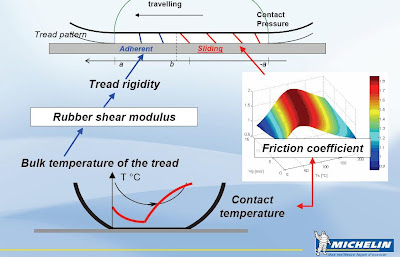Crucial_Xtreme wrote:Very good article from McCabe
A general theory of Pirelli's 2012 F1 tyres
The volatility of this season's Formula 1 season has been attributed to the temperature sensitivity of Pirelli's 2012 Formula 1 tyres. All of the teams are finding it difficult to keep the tyres in their optimum temperature band between 85 and 100 degrees C.
I'd like to propose a theory which explains what is happening. As I see it, there are two key facts, outlined by Mark Hughes in this week's Autosport, which need to be explained:
(1) Ferrari, Williams and Sauber tend to run their tyres hotter than Lotus, McLaren and Red Bull.
(2) In the past, when a tyre overheated, it would lose grip, and the temperature would then fall back into the operating band. This year, when a tyre overheats, it never recovers. Hence, a negative thermal feedback process has been replaced with a positive feedback process.
My theory depends upon the following facts about the physics of tyres:
(i) Tyre grip is generated by two mechanisms, sometimes referred to as physical grip and chemical grip. The first process involves the shear deformation of the contact patch, whilst the second involves the coefficient of friction of the tyre. The internal stress response to shear deformation depends upon the shear modulus of the tyre, which is temperature dependent, and the friction coefficient is dependent on both tyre temperature and slip velocity, (as depicted in the image below from Michelin's tyre modelling efforts). So both mechanisms by which grip is generated, are temperature dependent.
(ii) Tyre temperature is generated in a tyre by the deformation it undergoes, and by the friction associated with tyre slip.
 The key difference between this year's Pirellis and last year's, is that the 2012 tyre has a flatter contact patch. I hypothesise that what this has done is to change the balance between the heat generated by deformation and the heat generated by friction, in favour of the latter. This can explain our two key facts:
The key difference between this year's Pirellis and last year's, is that the 2012 tyre has a flatter contact patch. I hypothesise that what this has done is to change the balance between the heat generated by deformation and the heat generated by friction, in favour of the latter. This can explain our two key facts:
Firstly, if we accept that Red Bull, Lotus and McLaren have more downforce than Ferrari, Williams and Sauber, then the former teams will tend to suffer from less tyre slip than the latter teams. This explains why the former teams now run their tyres cooler than the latter trio.
Secondly, we can now explain why thermal degradation is a positive feedback process. When a tyre overheats and loses grip, it slides more. When the balance between slip-generated heat and deformation-generated heat has been tipped in favour of the former, a car which slides more will generate ever hotter tyres, leading to runaway thermal degradation. In contrast, in 2011, when a tyre lost grip, the deformation reduced, hence the temperature returned to the optimum operating band.
It's just a theory...
McCabism
Erm...
For one, who is to say where the teams have their blankets set? Where is this information coming from? If it were me I'd want no part of my tire sheets or setup info leaving my time, much less floating around in the public domain. Second.. a "flatter" footprint? ('contact patch') What does that even mean?
Everything else really gets into speculation / assumption / hand waving. The positive vs negative feedback loop thing in particular. Isn't clear if it's really referring to temperature or to actual degradation. Any and all heat history on rubber is going to evolve and change or degrade it. Heat history = area under the curve of temperature against time. Doesn't matter if you're in the "optimum temperature range" or not.
Also not sure I agree with the various teams "sliding" around more or less because of varying degrees of downforce. In an absolute sense, even the cars in the F1 grid with crap downforce.. have a lot of downforce. High downforce, big tires, low inertia... I'd say none of the cars are sliding around on fresh tires - as you'd see in other racing series with more sedan body types and heaps less down force.
So many other assumptions in there. That the "optimum operating band" is between 85 and 100C? Says who? Pirelli released that? Who is to say they know what the best range is? Best for what? Ultimate traction? "Grip"? Longevity? Wear?
Sometimes sounds like we're also assuming the 2011 tires were better than 2012. I recall tires in 2011 - particularly early on - disintegrating in "powdery wear" and giving up seconds a lap.
And as an aside - I agree the racing at Indy yesterday was quite good.
Grip is a four letter word. All opinions are my own and not those of current or previous employers.




